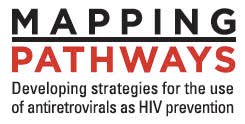
First Report on Antiretroviral Drugs for HIV Prevention to Bring Science Together with the Wisdom of Communities
June 19, 2013 – To make an impact on new HIV infections globally, antiretroviral (ARV)-based HIV prevention strategies need to be closely tailored to local contexts and cultures, according to a new report released today by RAND Europe and AIDS Foundation of Chicago.
“‘Mapping Pathways: Developing Evidence-Based, People-Centred Strategies for the Use of Antiretrovirals as Prevention’ [available by open access online on the RAND Europe website, and on the Mapping Pathways blog] provides an important resource to help communities, prevention programmers, funders and policymakers decide whether, and how, an ARV-based strategy could work in their locality,” said Jim Pickett, director of prevention advocacy at AIDS Foundation of Chicago and project director.
Last year, more than 2 million people globally became infected with HIV suggesting current prevention strategies are not doing enough to halt HIV transmission. Research suggests that some of the most promising prevention strategies are based on ARV drugs, such as pre-exposure prophylaxis (PrEP) and treatment.
“However, just because we know that ARVs can prevent HIV infection does not mean that we will, in practice, successfully implement their use in communities that need them,” said lead author Molly Morgan Jones, research leader at RAND Europe in Cambridge, UK.
Mapping Pathways is a community-led research project on the strategic use of ARV drugs for HIV prevention, involving RAND Europe, AIDS Foundation of Chicago and other partners in India, South Africa and the United States.
The group engaged more than 1,000 community respondents with an online survey and interviewed several dozen key stakeholders, including policy experts, program implementers, health care professionals and advocates. Participants rated the importance of various ARV-based prevention strategies, shared their perspectives regarding barriers to implementation and suggested the kinds of information they needed to make informed decisions about whether to implement any ARV-based strategy.
